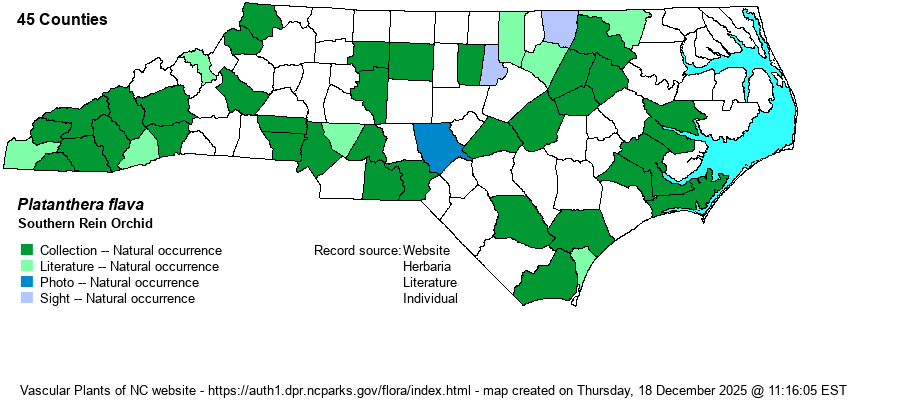| Author | (L.) Lindl. | |
| Distribution | A somewhat bimodal range, owing to separate varieties. The var. flava ranges over the western two-thirds of the Coastal Plain and much of the Piedmont, but it is spottily distributed over this large range. It seems to be absent from the eastern Coastal Plain (east of Northampton, Beaufort, Craven, and Carteret counties). In the mountains, var. herbiola is scattered over most of the province.
This species ranges from NJ and MO south to central FL and eastern TX; it is disjunct in Nova Scotia.
| |
| Abundance | Rare to locally uncommon in the Piedmont, including the Fall-line zone. Rare in the Coastal Plain. Rather rare in the Mountains. Where found, it can occur in dense stands of up to 50 or more plants. | |
| Habitat | This is a Platanthera of wet shaded habitats, being most often found in brownwater floodplain pools and other wet ground in lowland hardwood forests and bottomlands. It grows in a few similar habitats to P. clavellata, though that species has a wider range of moist habitats and does not grow in as dense stands as can P. flava. In the mountains, it is found in bogs, seepages, and other wet places, such as in swampy forested sites. |
| Phenology | It can bloom any time from March to September (according to RAB), but is usually in bloom from about May to July. It fruits shortly after blooming. | |
| Identification | This Platanthera looks quite a bit different from others in the genus. It grows to 1-2 feet tall and has a few narrow and erect leaves coming off the lower part of the stem. The inflorescence is a narrow raceme (and almost looks like a spike) instead of a more open raceme. The several dozen flowers tend to match the stem color, being pale greenish or pale yellow-green, curved to face downward; each flower is barely 1/4-inch across and contains a leaf-like bract beneath it. At first glance, it does not look like an orchid, even when in bloom, and one must often be within a foot of it to see the orchid flower structure. The most obvious aspect of the species is its proclivity of growing in fairly dense stands, often one plant just a few inches from another, with a population often covering 5-10 feet in diameter with many plants. | |
| Taxonomic Comments | Nearly all Platanthera species in NC were formerly placed in the genus Habenaria (i.e., as Habenaria flava). In recent decades, nearly all references have this species split out, but many consider them as varieties only -- P. flava var. flava and P. flava var. herbiola.
| |
| Other Common Name(s) | This is another Platanthera with no well-established common name. Other names include Northern Tubercled Bog Orchid (ugh!), Tubercled Orchid, Pale-green Orchid, and Rein Orchid. | |
| State Rank | S3 | |
| Global Rank | G4? | |
| State Status | | |
| US Status | | |
| USACE-agcp | FACW link |
| USACE-emp | FACW link |

